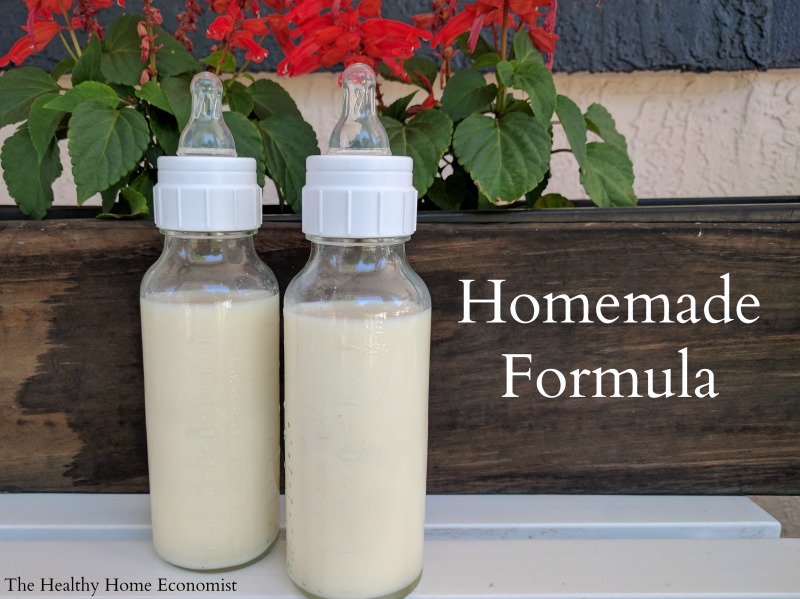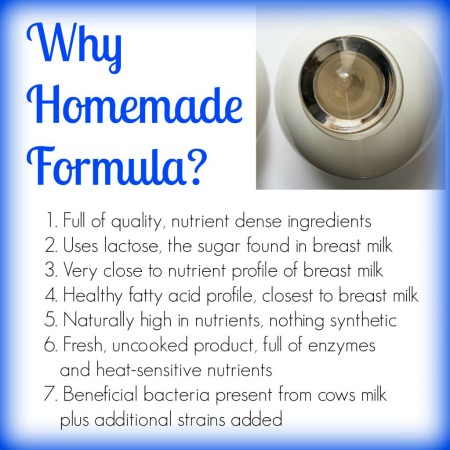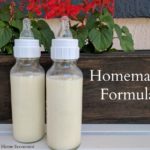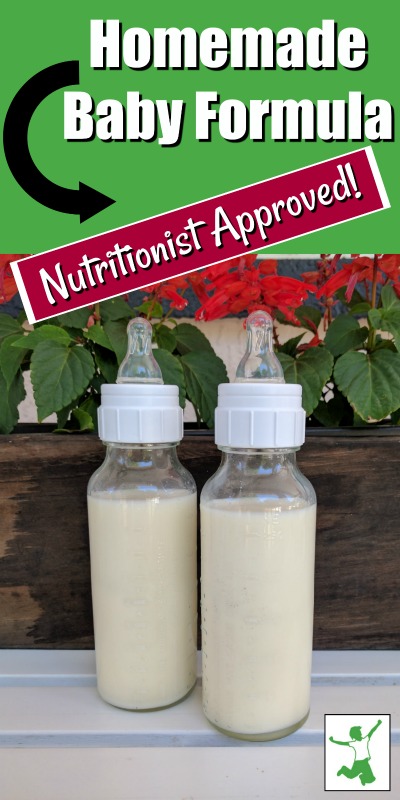Table of Contents[Hide][Show]
A nourishing homemade baby formula using safe, whole ingredients. This recipe was developed and tested by Dr. Mary Enig, a PhD Nutritionist and originally published in Nourishing Traditions cookbook in 1996. It was formulated to match breastmilk as closely as possible and is also suitable for infants. Source: Weston A. Price Foundation

There is no doubt that breastfeeding your baby is the best option for the child’s long-term health and development. Human breastmilk from a well-nourished mother is the perfect food for baby. However, in circumstances where the child is adopted or the Mother finds herself unable to breastfeed, formula feeding becomes necessary. In those cases, homemade baby formula is best.
Using a baby formula recipe that closely matches the nutritional profile of breastmilk is a far better choice than even organic baby formula from the health food store. More on this below.
Note: Donor programs are widely available for human breastmilk. But, the diets of the donor mothers are unknown and most likely nutritionally insufficient. In addition, breastmilk banks pasteurize the donated breastmilk which destroys much of the nutritional benefit. Unless you are fortunate to have a trusted and direct donor milk source in your community, avoid this option!
Dangers of Commercial Formula
Commercial formulas are always a poor choice for a number of reasons. First of all, formula manufacturers line the cans with the chemical BPA. This substance disrupts hormone development and is a probable contributor to early puberty in girls, and ADHD, urogenital abnormalities, and other ills in boys.
The European Food Safety Authority found that canned commercial formula is a significant source of BPA for infants, exposing the child to 13mcg of BPA per kg of body weight per day! BPA-free formula cans are no better. The chemical BPS is typically used instead which is just as dangerous.
Beware that manufacturers pack even organic commercial formula like Earth’s Best in BPA cans. Worse, they use organic brown rice syrup as the primary sweetener which is known to be frequently contaminated with arsenic.
In addition, all commercial milk formulas are processed at extremely high temperatures which violently denature the fragile milk proteins, render them allergenic, and add carcinogens to the final product. Soy infant formula is the worst. Obscenely high processing temperatures not only denature the proteins but large levels of phytic acid in soy block mineral absorption by the infant. Moreover, soy-based plant estrogens disrupt the hormonal development of the baby!
It seems that for the concerned Mother who is unable to breastfeed, learning how to make baby formula at home with safe, pure ingredients is the most prudent way to go!
Why Make Homemade Formula Even if You Are Breastfeeding
In the video below, I show you how to make your own safe, healthy raw milk homemade formula for your baby.
The recipe I follow was originally published in the cookbook Nourishing Traditions in 1996 and developed by Dr. Mary Enig.
Even though I breastfed each of my children for at least 2 years, I made this exact formula for my own children when I was away for the day or the evening as pumping was not an option that worked well for me.
I even used this homemade formula for an entire day once when I had some dental work done and was advised to pump and discard for 24 hours.
As a result, even successfully breastfeeding Moms can use this wonderful homemade formula as a supplement when necessary to their own nutrient-dense breastmilk!
It is advised that even breastfeeding Mothers have the ingredients for this formula on hand for an emergency. If Mom is sick or otherwise unable to nurse, Dad can step in and make this safe alternative until Mom is back on her feet. It takes a few days to a week to gather all the ingredients together to make this formula, which is why I advise having them on hand at all times.
Homemade Most Nutritious
The image below lists the reasons why it is worth it nutritionally to make formula yourself for your precious baby!
You can order all of the required ingredients for the homemade baby formula in one package from this reputable, vetted source.
Moms who have successfully used this formula feeding your children, please post about your experience in the comments section to encourage those who are considering it and need some Mom to Mom encouragement!

Where to Source Quality Milk
The most widely available grass-fed milk around the world is from cows. This is usually the most budget-friendly and easily sourced milk for this recipe for homemade formula.
If only goat milk is available in your area, this recipe for goat milk baby formula can be used instead. When using milk from ewes, please refer to the linked article for an adjusted recipe; one of the benefits of sheep milk is that it is higher in healthy fats than either goat or cow milk.
Camel milk formula is another option that is a particularly digestible form of dairy and growing in popularity around the world.
Alternatively, you can use low temp (vat) pasteurized, non-homogenized whole milk cultured with a piima or kefir starter. Then substitute the piima milk or kefir for the raw milk portion of the formula recipe. Cold-pressed raw milk also must be cultured before using it as it contains no probiotics.
Do NOT use ultrapasteurized (UHT) milk even if organic as it is too highly processed and extremely allergenic!
It is also best to avoid all types of powdered milk for this recipe. The factory process of making milk powder reduces nutrition considerably and denatures it, which makes it more likely baby will have an allergic reaction.
Dairy Allergy Option
If all types of dairy prove unsuitable for your baby, make this nondairy baby formula recipe instead. It uses a base of homemade bone broth as a substitute for milk. It is important not to utilize a plant-based or otherwise vegan baby formula recipe.
Avoid buying bone broth to make the dairy-free formula. Make it yourself! Manufacturers of commercial bone broth, even if authentic, may water down the end product. This is apparent if it does not gel when chilled in the refrigerator.
Many brands have toxic packaging issues as well. If you must buy it in a pinch, see my shopping guide page for vetted brands that are safe.

Homemade Baby Formula Recipe (for infants too)
A nourishing baby formula recipe you can make at home with safe, whole ingredients developed and tested by a PhD nutritionist to match breastmilk as closely as possible. Also suitable for infants.
Ingredients
- 2 cups raw cow milk OR organic whole milk yogurt
- 1 7/8 cups filtered water
- 1/4 cup liquid whey
- 4 Tbl lactose
- 1/4 tsp Bifidobacterium infantis powder
- 2-4 Tbl raw or pasteurized cream
- 1/2 tsp cod liver oil unflavored
- 1/4 tsp butter oil unflavored
- 1 tsp sunflower oil preferably organic
- 1 tsp extra virgin olive oil preferably organic
- 2 tsp virgin coconut oil preferably organic
- 2 tsp nutritional yeast
- 2 tsp gelatin
- 1/4 tsp acerola powder
Instructions
-
Fill a 2 cup Pyrex measuring cup with filtered water and remove 2 TBL (this will give you 1 7/8 cup water).
-
Pour about half the water into a pan and turn burner on medium.
-
Add the gelatin and lactose and let dissolve, stirring occasionally.
-
When gelatin and lactose are dissolved, remove pan from heat and add the rest of the water to cool.
-
Stir in the coconut oil and butter oil until melted.
-
Put remaining ingredients in a glass blender.
-
Add the water mixture and blend for about 3 seconds.
-
Place formula in glass baby bottles or a glass jar and refrigerate.
-
Before giving to baby, warm glass bottle in a pan of hot water or a bottle warmer. NEVER microwave baby bottles!
Recipe Video
Recipe Notes
If using raw cow milk from holstein cows, use 4 Tbl of extra cream (otherwise use 2 Tbl extra cream).
If choosing to make this homemade formula with camel milk, be sure to include 4 Tbl extra cream as camel milk is lower in cream than cow milk.
Do not use high oleic sunflower oil. Use only the brand recommended in the ingredients list which is cold pressed, organic, unrefined, and low oleic.
*Do NOT use powdered whey from the store as it is denatured. Avoid whey from making cheese as it will curdle the formula.
*Do not substitute pasteurized or powdered milk as these are heavily processed, denatured and allergenic foods.
*Do NOT use ultrapasteurized (UHT) cream. It is highly allergenic. Raw or pasteurized cream is acceptable.
*Do NOT use fish oil or krill oil instead of high vitamin cod liver oil as they do not contain any Vitamin D and very little to no Vitamin A.
Collagen powder may be substituted for the gelatin in a pinch (more on peptides in baby formula in this article).
If you are wondering where is the iron in homemade baby formula, this article provides an explanation.
If baby experiences constipation using this formula, try adding 1 tsp of molasses to each batch. This should help move things along.
How to Transition to DIY Formula
Once you’ve viewed the video, gathered the ingredients, and made your first batch, how do you feed it to your baby for the first time?
It is important not to switch all at once as this can cause gas, excessive spit-up, or an uncomfortable change in diaper habits such as constipation or overly loose stools.
Start by giving your baby three-quarters of the old formula blended with one-quarter of the homemade. Try this ratio for a day or two and see how your infant responds.
If no digestive upset or major change in diaper habits occurs, increase the amount to a 50-50 blend of old formula to homemade. Observe for another day or two as before.
If no major issues, increase once again to three-quarters homemade formula to one-quarter old formula. If baby does well on this blend for a third time, you are ready to fully transition to the homemade formula.
At any time during the transition, symptoms of intolerance emerge, back up to the previous successful blend ratio and stay there for a day or two before attempting to increase once again.
Homemade Formula FAQ
Weston Price Foundation
Feeding an Adopted Baby
Traveling Tips with Baby Formula Made at Home
Iron in Baby Formula
Collagen Peptides instead of Gelatin for Homemade Formula?










Maybe these are dumb questions… I am an european so these measures are a bit tricky here.
1 cup = how many ml?
(TSP) = a TeaSPoon
(TBS)/TBL = a TaBleSpoon
right?
I have all the ingredients for making the formula. However I have no access to filtered water (yet). Can I use bottled water for now?
Last one: we have pasteurized cream in supermarkets but I would love to use a better thing than that. There is a special brand of “rømme” (which is ‘sour cream’ in Norway) pasteurized BUT not homogenized like the other dairy products are. Can I use this sour cream instead of pasteurized and homogenized cream in the baby formula?
Thank you a lot 🙂
I am really excited about this. Cross your fingers for us (I really hope my baby loves this formula!)
A hug from Norway 🙂
Hi Sarah! My mom pointed me to your blog recently and I’m eager to try this formula. I’ve seen other videos around but you are the first to explain the vitamin k in the butter oil.
I am due to deliver my fourth in less than 4 weeks and am researching normal newborn care and want to make much different,natural decisions with this baby. I have never made enough milk to fully breast feed my children. I also have never eaten as healthfully as I am now, so I’m hopeful that nursing will go better this time around, but in case it doesn’t, I want to have these formula ingredients ready to go. I’d really love to hear if folks have success freezing this so I could possibly go ahead and have some made.
Anyway, my question is about the vitamin k. I will be declining the shot and was planning to use oral drops. If I’m exclusively nursing, I assume I will need the drops, but if I use the formula, would the amount of vitamin k in the butter oil be enough?
Also, I was just reading about the antibiotic eye drops. Did you decline these? Did you get push back?
Thanks!
Hi Sarah
I just can not decide the “TBL” and the “tsp” both means teaspoon?Or what is TBL means?
I started now to learn to make this baby formula and I stuck in this “TBL” thing.
Thanks for you answer
Regards:Marietta
Our 4 mo adopted daughter has been on the Weston Price homemade formula recipe (goat’s milk based as we don’t have a source for raw cow’s milk) since an outbreak of thrush at 4 wks old. Her mother had been on 3 antibiotics prior/during delivery. But, our daughter has never been on anything herself nor has she had any vaccines.
A rash popped up about a week or so after starting her on the homemade formula (perhaps a coincidence). It was mild and splotchy at first, but then transitioned into dry/bumpy skin in mass. It would flare up at times (I feel like it’s after she eats, but am not sure) and yesterday, it went crazy after I showered her using a pea size drop of castile soap. I bathe her about once a week b/c of her “dry skin”. She is biracial and I had been using a soap for her skin type, but thought that may be the problem so switched to Bronner’s Castile Soap. Not sure if it was the heat and moisture of the shower or the soap or the fact that I just fed her that made it flare up. But, I’m very concerned and wondered if you could recommend where I can start attacking this issue.
I have an appt with our naturopath on Monday, but love your website and respect your experience with this particular formula and infants.
Any ideas you can give me are greatly appreciated. My husband keeps saying to just put her on Earth’s Best and she’ll be fine, but I’m determined to feed her the best I can and commercial formula is not an option.
Thanks in advance.
Elexa Wagaman
Is it ok to use this
for the bifidobacterium infants powder?? It’s the Garden of Life Primal Defense Kids probiotic formula.
Hi Sarah,
I just made my first batch of this formula and was wondering if I should slowly transition my son into it? He’s 10 months old and currently on commercial formula. Half and half for a while or is it okay to give him the full homemade formula?
Thanks so much!
i started my son on it immediately and had no ill effects. in my opinion, it’s worse to keep the commercial formula going.
Hi Sarah,
I am trying to locate a provider for raw milk from grassfed cows. I live in Sandwich, Illinois about hour west of Chicago. I want to begin to make my homemade formula ASAP. Thank you.
I have preemie twin boys that are now 3 months and a week old. Since birth they have been on similac neosure but seeing the ingredients makes Mr want to change it to somthing healthier. Also I believe the formula upsets their stomachs and makes them very uncomfortable. They are only eating about 4 ounces every four hours so how should I go about making 36 ounces of formula for each baby every four hours. Is it safe to put it into the fridge for how many hours? This is my main concern other than changing their formula without concent from pediatrician because they say it’s too soon
HI Sarah , Happy New Year,
My wife and I love having being able to give our newborn the same great raw milk we have been enjoying for a couple of years now.
Although, I have a question I need your help with; We just started the formula and made our 2nd batch yesterday. We only made a half batch (cutting all ing. in half) because our boy is still drinking breastmilk and we want it to be freshmade. But the mix when put in the fridge has become a gelitin like texture, when shaken up it breaks up and seems very thick. When heated in the bottle it goes back to the regular milky texture but i wonder if something was wrong with that jelly like state. Is there something wrong with making a half batch? Can you help? thanks in advance!
mine goes jelly like too. i have been trying to find info online where someone with experience addresses this, but so far nothing. i am considering putting the formula directly into 2.5 ounce plastic containers i have after i make the batch, and then i can just put those little containers in warm water to re-liquify it before pouring it in the baby bottle. otherwise i have to use a spoon and try to get it in the bottle which is hard and messy.
Hi, I had this problem too and I started using only 1 tsp of gelatin rather than 2. That solved the problem for me!
Thanks, I reduced it from 2 tablespoons to 1. It is not set hard like before, but still sets up a bit. What I decided to do: When I make a batch of the formula, I pour it into these 2.3 ounce containers that I have, called snappies. You can buy them online. I ended up with a ton of them from the hospital because baby was a preemie and we were there for a while. They are designed for breastmilk and reuseable. Anyway, I pour them into those containers. When I am going to make a bottle, I put those little containers in warm water. It melts the gelatin. Then I just pour it into the baby bottle with some breast milk and it’s good to go. Since I am doing it this way, I may try it again with the full amount of gelatin and see how it goes.
oops, teaspoons